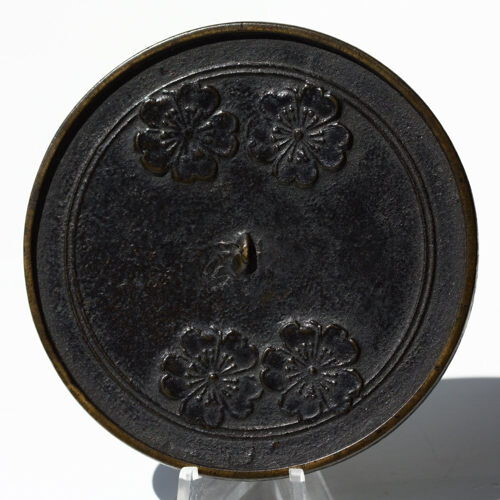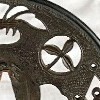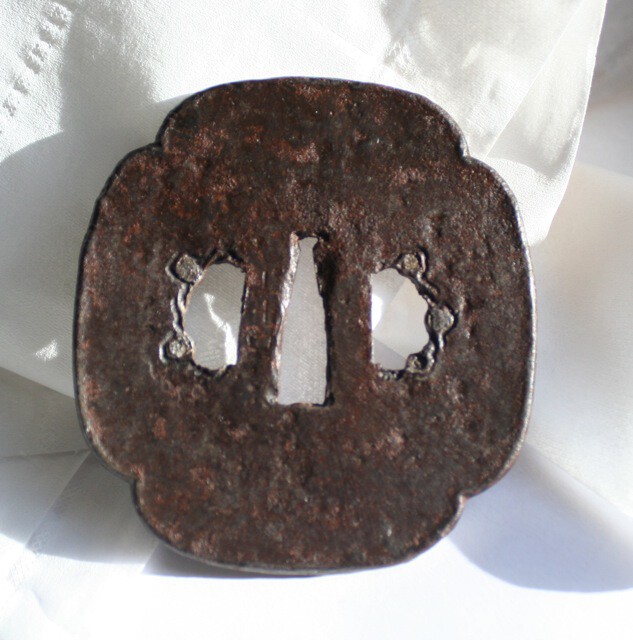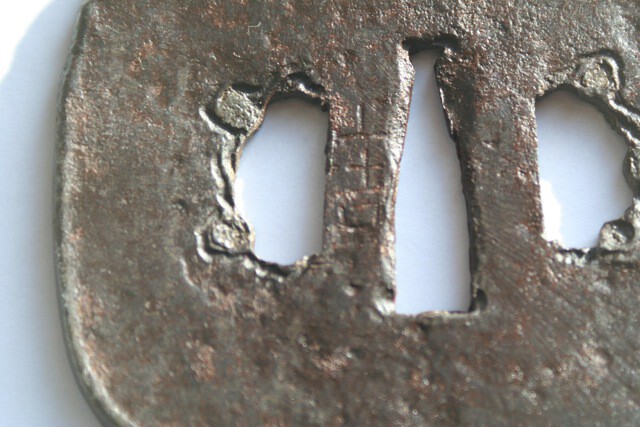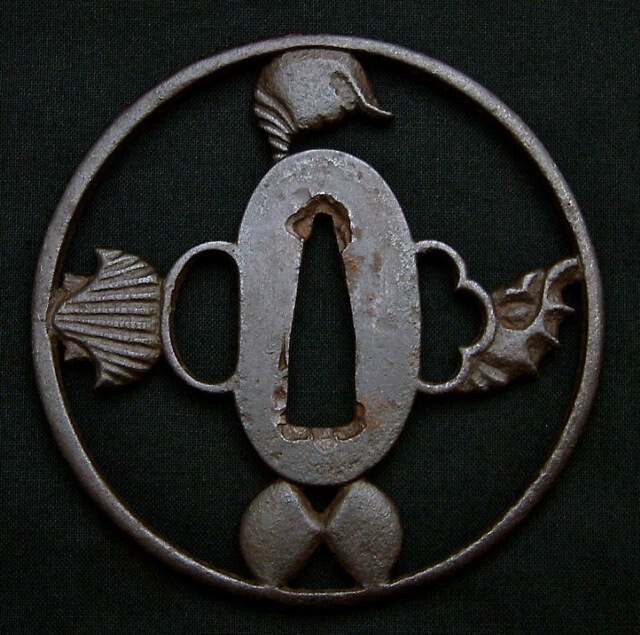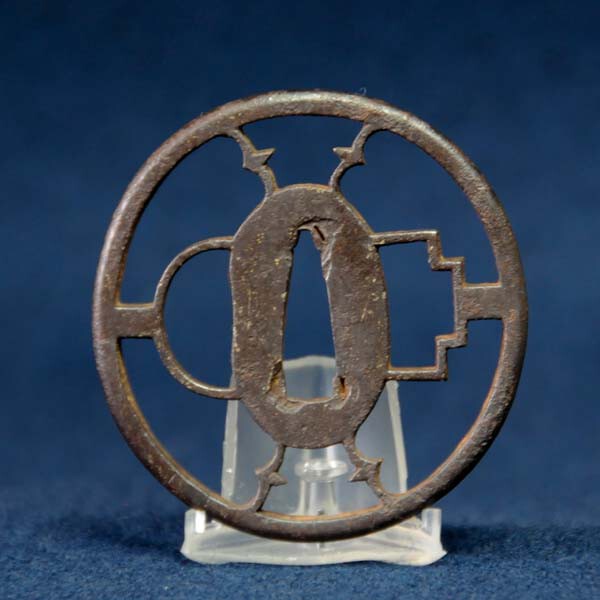-
Posts
3,157 -
Joined
-
Last visited
-
Days Won
26
Content Type
Profiles
Forums
Events
Store
Downloads
Gallery
Everything posted by Marius
-
Good idea, Philip! Let us start then, here is one tsuba I have bought and regretted having done so. I have a couple more,so if your idea catches on, I am going to post them :-)
-
Dear John, sorry to reply with a delay - somehow I didn't see that you have added your attributions and that the thread was not closed :-) Many thanks for the valuable input - I have learnt something thanks to you and Marc One question - what makes you think the wachigai tsuba is modern? Not that I would disagree, but the patina on it is much deeper that on #3 (the undoubtedly-Owari tsuba). It is very dark, almost black, I cannot reflect this in my pictures... Maybe some other characteristics which betray its young age?
-
Henry, Steve, many thanks for your input. No doubt that this tsuba is gimei. I wouldn't expect a Yamakichi for the price I paid :D BTW, Steve's tsuba shows a wonderful patina and a very moist look, while Henry's looks a bit dry and my impression is late Edo Saotome (despite the molten mei). But then again, who am I to give an attribution... The rust spots on my tsuba seem only skin-deep, but they do exist. Patina does not indicate great age, but my untrained eye can be mistaken... Those plugs are a mystery... The yasurime seem very good quality to me... Shall we say - it is a late Edo revival piece woth a false mei added later?
-
Hi Stephan, I have bought a Shimosaka Yasutsugu School wakizashi with NBTHK hozon from the same dealer :-) Very substantial and heavy blade. Nagasa 43.1cm Sori 1.1cm Motohaba 29.4mm Motokasane 7.0mm The unokubi zukuri shape makes it look like a naginata-naoshi, but it is an ubu blade. Attached are some pics.
-
Dear All, I have recently bought a rather intriguing tsuba. It is made of iron, slightly raised rim, finished in tsuchime, with very faint Amidayasuri. Some surface rust of purplish colour, otherwise good, brown patina. Granular and linear tekkotsu in the rim. The most intriguing thing in this tsuba is the way the kawari-gata hitsu-ana are finished - they are adorned with what seems to be tiny plugs made of lead or lead/zinc alloy. The plugs have grey patina so they clearly stand out from the iron plate. The tsuba is signed - you will surely make out what the mei is. I find it rather clumsy. an interesting feature is also that this tsuba seems to have been mounted on either side - both sides have what seems yose-tagane. Both hitsu ana have been fitted with soft metal inserts, these have been lost. Dimensions: 8.5 x 7.9 cm Seppa-dai thickness: 3 mm Rim thickness: 4 mm Thanks for looking Your ideas on this tsuba would be greatly appreciated PS: sorry for the download time...
-
Congratulations, Jean & John
-
Dear All, I presume that most of you have seen it already, but just in case: at Yamabushi Antiques Boris and Andy have got what seems to be a rather nice ko-kinko tsuba collection at what seem to be good prices. It is consignment stock and is to be found here: http://yamabushiantiques.com/YBA2_CONSIGNMENT.htm Disclaimer: I am in no way connected with Yamabushi Antiques and I will get no money or any other advantage out of this post. I am their regular client, and on a routine visit today, I have noticed some tsuba that seem very nice and good value to me. Just wanted to share.
-
Richard, thank you. I am happy that you like it. With your opinion I would consider this thread closed, unless someone else has good arguments in favour of a different arttribution. Thank you and Ian for a opportunity to advance my modest knowledge.
-
Ian, thank you very much for this important point. It does look indeed like sasa, perhaps the golden drps are representing dew? It would be illogical to have dragonfly on this side. With the bamboo grass the design is coherent.
-
Gearge, first of all, many thanks :-) Always impressive how quick NMB members are to help a poor ignoramus. I got the tsuba in this box, maybe it it just a random box the seller had? Anyhow, thanks again
-
Dear All, I have a tusba (see viewtopic.php?f=2&t=6859) which has come in a box. There is what I suspect might be an attributionon, on the box. Would you kindly help me with this writing? Thank you ever so much for your time and kind help
-
Dear All, I have recently acquired a nice tsuba. Made of iron, tsuchime-ji with kin-zogan details. Motif of cherry or plum tree, with dragonflies on the back side. A friend and collector has suggested it might be in the style of Saga Kaneiye, but on second thought Saotome. I had the same impression with Saga Kaneiye, but I guess it might be Mito, as well. I wonder what your opinion is? Size 88x82 mm thickness: 3 mm Attached are some pictures. Thanks for looking
-
Forgive me, but isn't the correct writing of the name "Ii" ? Is "Iie" also a correct form?
-
Tired but polished - yes. But rusted with nicks? Hmm....
-
OK, here are the details (I have put them in the pic's descriptions, too - for your convenience). I can't say how the sukashi were cut, they look all the same to me, sorry Some of the sukashi are rounded, I have indicated this in my description. # 1 7,4 x 7.3 mm nakago ana th. 4mm mimi th. 3.5 mm no tekkotsu, polished, smooth. flat rim, rounded on top, rather slim # 2 6.9 x 6.5 mm nakago ana th. 4mm mimi th. 3 mm rounded rim, smooth surface, polished sukashi rounded as well #3 6.8 x 6.5mm nakago ana th. 4.5mm mimi th. 4mm flat rim rounded on top no tekkotsu, delicately hammered? #4 7.2 x 6.5mm nakago ana th. 5mm mimi th. 4mm round rim and sukashi no tekkotsu, polished Forgive me my untrained eye...
-
I see. That would be very interesting. What advantage would an unsharpened sword have over a bludgeon or/and a jutte... But then again, Musashi Miyamoto was successfully fighting with wood swords... Everything is possible in Japanese sword history
-
You may be referring to jutte (or jitte), a defensive weapon used by the Edo period police, the so called doshin (consisting of samurai, of course). Jutte was by no means a sword. Google "hachiwari" and "jutte" to get more info.
-
Thank you John, I do apreciate it I will try to post as much information as I can get out of these tsuba. This will be a great opportunity to learn. Not sure though how I shpld identify how the sukashi were cut?
-
Dear All, These are some of my sukashi tsuba, which, being a beginner, I cannot attribute. I would truly appreciate your input. A tsuba similar to the one with the wachigai is featured in Haynes - catalogue 5, page 32. Thanks for looking
-
Hi Deborah, can you post some pictures of this sword? The whole shape, both sides of the tip and the tang should be shown separately. Pictures of the mounting would be interesting, too. Without pictures it will be rather difficult to tell you anything about the sword.
-
No, it is not. Sayagaki is a an attribution written by a sword appraiser on the sword's saya. Your paper is called a Torokusho. I assure you that you could You may want to read this thread: viewtopic.php?f=1&t=6473 This is a Torokusho, or a certificate which confirms that the sword is a traditionally made nihonto. Please read this excellent guide of the Japanese Sword Society of the US: http://www.jssus.org/nkp/japanese_sword_laws.html
-
Dear tagonagy (BTW, what is your name?) that was my impression too, I just didn't want to sound as if I were an expert (I am not). Dear John, thanks for this comment. I have had the same impression, but then again, sometimes activities in the hamon (or rather yakiba like here) are only a reflection of the hada. Also, the hamon is not alwayts visible in pics, the yakiba is always.
-
You have hit the nail on the head, Brian :D Oh, and many thanks to Ted for the information on the Enomoto hada. I appreciate it
-
the hada on the Sadayoshi John has posted, yes. The sword on eBay...
-
Thank you gentlemen :-) I have made a fool of myself :-)

